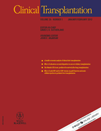Institution of extracorporeal membrane oxygenation late after lung transplantation – a futile exercise?
Conflict of interest: The authors have no conflict of interest to declare.
Abstract
Marasco SF, Vale M, Preovolos A, Pellegrino V, Lee G, Snell G, Williams T. Institution of extracorporeal membrane oxygenation late after lung transplantation – a futile exercise? Clin Transplant 2012: 26: E71–E77. © 2011 John Wiley & Sons A/S.
Abstract: The use of and indications for extracorporeal membrane oxygenation (ECMO) are expanding as its reliability improves with widely varying results reported. A retrospective review of 24 lung transplant recipients who required ECMO support postoperatively was performed with 13 patients requiring ECMO within the first 48 h (“early” group) and 11 requiring ECMO after seven d postoperatively (“late” group). The majority of early ECMO group had primary graft failure patients and the late ECMO group comprised patients with infection or non-specific graft failure. There were significant differences in outcomes between groups, with 10/13 in the early group and 4/11 in the late group successfully weaned from ECMO (p = 0.045). Six of the 13 patients in the early group and none of the late group survived to hospital discharge (p = 0.009). The late ECMO group had a much higher incidence of death owing to complications existing prior to institution of ECMO (essentially uncontrolled infection or organ failure). There were no differences in complications arising during ECMO between groups. Late institution of ECMO in lung transplant recipients for causes other than primary graft failure is associated with such poor survival that its use should be considered only in very select cases.




